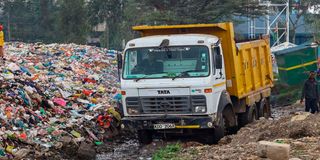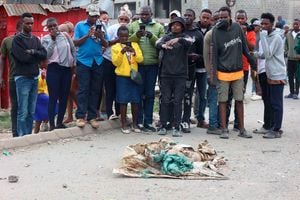
A man carries recyclable waste at Kware dumpsite in Mukuru Kwa Njenga, Embakasi South Nairobi on July 30, 2024.
Deadly, feared, and enshrouded by mystery, the abandoned Kware quarry-turned-dumpsite in Kenya’s capital Nairobi has become a subject of both awe and trepidation.
Some three weeks ago, the country was sent into a frenzy when mutilated human bodies started surfacing from the sprawling, almost ungovernable dumpsite.
Official police records show that at least nine bodies were retrieved— a figure that locals have rejected, saying they personally counted at least 15 bodies found at the godforsaken place.
But how did Kware come to be? And besides being a garbage and death dumping site, what else goes on this five-hectare, derelict piece of land.
Before 1940, the name Kware did not exist, as it was part of the larger Pipeline and Mukuru Kwa Njenga.
Kware sprung up in name and place when the then solid piece of land in Embakasi South was ripped apart in search of stones and ballast for erecting business and residential buildings in the capital.

John Maina scavenges pig feed, which he sells at Sh 80 per 50kg bag for his daily income, at the Kware dumpsite in Mukuru Kwa Njenga, Embakasi South Nairobi on July 30, 2024.
The industrial-scale quarries were baptised “Kware”— how a typical Kenyan pronounces the name-quarry— by Nairobians who came and settled near the stone mine in search of menial work. Initially, there were three quarry sites, two huge and one small.
Deep hole
Come the year 2000, the first huge quarry was exhausted and was duly covered as it should, with tippers filling the deep hole with soil and rocks gathered from construction sites across the busy Nairobi City.
The second quarry that got exhausted was the small one but it was not duly covered as it should have been when its usefulness ended.
To date, the quarry remains just next to the Kware dumpsite and often fills up with water when there are heavy rains or floods.
“When the water filled this small quarry to the brim, it overflowed and it is this water, combined with the full Ngong River, that flooded the entire village next to Sinai,” says Erick Ambuche, the founder of Slums Outreach Programme in Mukuru Kwa Njenga.
It was in 2007 when the second large quarry stopped yielding stones and ballast. It was supposed to be filled just like the first pit, but this did not go as planned.
Over time, garbage collectors realised it was the perfect spot to dump waste from the densely populated Kware area, Mukuru Kwa Njenga and Sinai slums.

A truck carrying garbage enters the Kware dumpsite in Mukuru Kwa Njenga, Embakasi South Nairobi on July 30, 2024.
Slowly, this habit became entrenched and residents to date continue to dump their waste at the quarry, alongside the lorries that still fill the pit with the right materials; soil and rocks.
Access to Kware
The quarry site can be accessed from three main routes.
One can come through the Sinai slums direction, or using the route that comes straight from Outering Road at the Kware bus stop.
This route cuts through Kware up to the Kware Police station before winding to Mukuru Kwa Njenga.
The third route has a gate that is managed by an entity called Makao Bora. This is what many people use when visiting a football field located right next to the quarry where the bodies were found.
Locals believe this is the route that the alleged serial killer, Collins Jomaisu, who is linked to the body-dump find.
Investigations by the Nation at the quarry reveal that life and death live side by side at Kware.
Once a quarrying paradise that supported both the rich and the poor, here are the many shades and colours of Kware— the emerging capital of the criminal underworld in Embakasi.
A business hub
Though many locals have expressed concerns over the untenable state of the abandoned quarry, they also know well that shutting the place down would result in a revolt, fights and increased cases of thefts and robbery.
This, for the simple reason that the quarry cum dumpsite has turned into a thriving business centre.
For instance, there are about a total of 50 hand carts at the dumpsite area. These are crucial for business for the around 15 men who man the entire quarry.
Every handcart operator parts with some Sh50 whenever dumping their waste at the zone. There is a ‘chairman’ who collects this fee and at the end of the day, redistributes it to his ‘’boys”.
This same script goes for the lorry drivers who part with at least Sh500 to dump their waste and or soil, as required.
“In any given day, at least a hundred lorries visit the quarry. This is a business empire that no one dares touch. We all know it, and we wonder how the police let these young men collect this fee that never finds its way to the county or any government office,” Fred Lusabe, a youth in the area said.

Learners queue to cross a dilapidated bridge at the Kware dumpsite in Mukuru Kwa Njenga, Embakasi South Nairobi on July 30, 2024.
Also, there is the business of rummaging through the dumped waste to find items that still have value and can be salvaged and their utility revived.
This could be pieces of steel, aluminium and metals that the youth pick, put in their sacks and go sell them to steel and metal dealers.
A kilo of metal goes for around Sh25 while a kilo of aluminium (Sh70) and copper (Sh100).
There are also women who collect food waste, particularly ugali, which they sell to animal feed companies.
“This is where we find money to pay for our needs and children’s school fees. We are not criminals, we work hard for our money. Why would anyone think of taking this away from us?” Martha Musembi, a local in Mukuru Kwa Njenga posed.
There is also a temporary bridge connecting Mukuru Kwa Njenga, Kware and Sinai at the edge of the huge quarry.
It was built by an elderly man, who also has his army of “boys” who stand some distance as their boss collects “fare” from locals who use this route to get to their homes and go to work every single day.
Though the cost is low, Sh10, per person to cross the barely five-metre long and one and half metre-wide bridge, the sheer number of people using the bridge makes the business very lucrative.
At times, particularly in the morning, people even queue to use this wooden bridge.
A drug den
Amongst the many youths who visit the dumpsite, either to find a chilling spot, or work, under the leadership of the “chairman”, a well-known, yet well-kept secret, is the role of the feared dumpsite as a crucial artery for hard drugs.

Rose Ndunge sorts recyclable waste that she sells for her daily income at Kware dumpsite in Mukuru Kwa Njenga, Embakasi South Nairobi on July 30, 2024.
Bhang leads the list of the illegal drugs found there, and recently, heroin, according to police. The latter, locals say, found its way to the Kware dumpiste after the closure of another notorious dumpsite in the heart of Mukuru Kwa Njenga in 2022.
Incidents of youth, dazed and intoxicated by the deadly drugs engaging in fights using sharp objects including broken bottles, rusty knives, no longer fazes residents and workers.
Though their acts are deemed low in the morality index, their spirits are often high, lifted by the intoxicants they consume.
“The happenings at the quarry are very scary. Our children are perishing right under our watch. Who can dare walk into the dumpsite to stop them from wasting their lives away when we all know one might not come back from there?” Mr Ambuche posed.
The fact that the Kware police station is right next to this dumpsite yet these habits continue is a mystery no one can explain fully.
In the wake of the body-dump find, acting Inspector General of Police Douglas Kanja transferred all police officers on July 14 as investigations into the macabre killings went on.
Health Hazard
With all manner of solid, organic and plastic wastes being dumped at the site without any form or order, the repulsive smell emanating for the quarry is a serious air polluter with locals constantly complaining of their stomachs being filled with “gas”.
“Children contract respiratory diseases including asthma from a tender age, some are diagnosed even as early as when they are a few months old, “Rose Mwinzi, a local in the area said.
“’Tuberculosis is currently a common disease among adults here, and going with the poor hygiene, it spreads even further. This abandoned quarry is hitting us in all corners.”
The fact that medical wastes, including injection needles are dumped at the site make it even worse.
These biohazards, locals say, are the same ones often used by the drug addicts to inject themselves with the drugs.
Insecurity
Whoosh! The gust of wind is not even settled when yet another young man swishes past this reporter while interviewing a local in Kware.
Then almost immediately, shouts of “catch those boys, they are thieves!”
No one moved. Reason being, hii ni kawaida, (this is the norm), the locals said.
Knowing well the dumpiste is feared by many, roughnecks in Kware and Mukuru Kwa Njenga have turned the quarry into their haven where they run to with their spoils after robbing unsuspecting Kenyans, who in their thousands, use that route when going to work at the nearby Industrial Area.
“We are used to the screams. No sane person can dare walk through this place either going to Sinai or Mukuru Kwa Njenga alone. You must at least be two and be ready to run the entire length of the quarry,” Mr Lusabe said.
The fact that the footpath used to connect Mukuru Kwa Njenga and Kware to the populous informal settlement of Sinai is rough, dilapidated and in terrible shape, makes it even harder for targeted victims to escape their drug-fuelled, adrenaline pumped captors who will stop at nothing to rob.
So common is the vice that locals seldom report cases of theft and/or robbery at the police station because “no case ever gets solved”.
During the clash between the police officers manning the quarry when detectives were retrieving the bodies and processing the scene and rowdy locals, many people thought it was the typical cat and mouse games occasioned by the discovery of the bodies.
In reality, the majority of the protestors told the Nation that they were protesting the laxity of the police officers at Kware police station. That they were unhappy by how the bodies could be dumped at the quarry when the police officers were stationed at a place they could easily pick out any strange happening.
“We want this station to go down and everyone here not transferred but taken in by the detectives to share all the details they have regarding these murders and the rampant insecurity in Kware,” Mr Ambuche said.
Often, locals report their cases to Villa Police Station.
Superstitions galore
This very quarry, now dumpsite, harbours a strangeness that no one can quite well describe.
For locals, its acquired its macabre status when in the year 2002, a well-known community figure in Mukuru Kwa Njenga died by suicide after jumping into the quarries.
“It is said that he decided to take his life after discovering that he was HIV positive. At that time, having the virus was tantamount to a death sentence. He could not live with it, and he did what he did,” an elderly local named Njoroge said.
Since then, the locals believe that the quarry has been “calling” other people and they are sure (but cannot prove) that the lives of many people have been claimed by this deadly pit that has in recent weeks been established to be the final home of many abandoned people.
Incidents of tippers falling into the pit have also been recorded.
To date, truck drivers leave their doors open when offloading materials into the deep pit measuring some 100 metres deep. This, they say, will ensure that when the pit comes “calling” they can easily jump out and let the lorry sink into the abyss.
The last report of a lorry falling was in 2022. The driver managed to escape using the aforementioned tactic.
The youth, after realising the lorry was not yet fully submerged in the pit, managed to get to its bonnet and removed the vehicle’s battery.
Call for help
This quarry, many locals said, should be circled by a perimeter wall and managed by the City County, and not left to the hands of miscreants and youth of questionable character.
They blame the National Environment Management Authority, the Nairobi City County and the police for not taking note of their concerns regarding the death trap lying next to their doors.
“A 50 by 100 plot is already priced at Sh12 million once the quarry is fully filled. My main worry is that the place will not be fit for constructing highrise buildings because the materials being used to cover it are not purely rocks and soil. This means the foundation will not be strong to sustain the tall buildings in the future and could result in more deaths,” Mr Ambuche said.
The treasure that is Kware partly explains why leaders of both Mukuru Kwa Njenga and Kware wards have laid claim to the quarry.









